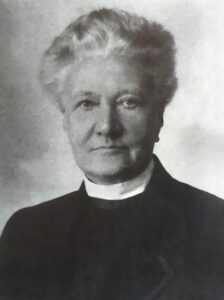By Ann Eberwein

Dr. Mary Brodrick, Egyptologist
Mary Brodrick (1858 – 1933) was an archaeologist and Egyptologist of great distinction and was one of the first women to excavate in Egypt. She began her academic career at age thirty after a trip to Egypt in the winter of 1888 during which she sailed up the Nile and became fascinated by ancient Egyptian history and culture. Upon returning home to London, she sought to study Egyptology and archaeology but found no local institutions that women were permitted to attend. Brodrick then decided to contact Gaston Maspero, a professor at the Sorbonne in Paris. Maspero, who had previously worked as director-general of the Egyptian antiquities service, was initially reluctant to admit Brodrick, but he did bring her case to the council of the Sorbonne, which found that there were no rules prohibiting women from attending. Brodrick attended lectures at the Sorbonne and the Collège de France studying Egyptology, demotic, Coptic, Egyptian law, Hebrew, “Semitic archaeology,” and Roman law and history.
Returning to London in 1890, Mary Brodrick was then permitted to enroll at University College, London, where she studied archaeology and Egyptology under Sir Flinders Petrie. She also began working with Peter Renouf at the British Museum were she eventually taught three courses in Egyptology and Archaeology. At that time there were few English-language Egyptology textbooks, so Brodrick revised and translated several texts including Egypt Under the Pharaohs: A History Derived Entirely from the Monuments (1891) and Outlines of Ancient Egyptian History (1890). After serving as English honorary secretary for the Egypt Exploration Society in the U.S., Brodrick received a PhD from the University of Kansas in recognition of her work. From 1894 to 1896 Brodrick lectured in Europe and Egypt, wrote A Handbook for Travelers in Lower and Upper Egypt and held a Pfeiffer fellowship from the council of College Hall. Then for nearly a decade (1897-1908) she worked in Egypt and collaborated on several publications. Brodrick excavated during the warmer months and spent winters on the Nile sailing in a Dahabeah, a type of shallow-bottomed barge used to traverse the river since the time of the Pharaohs. During this period, there were increasing numbers of British women working as archaeologists in Egypt including Kate Bradbury, Emily Paterson, Margaret Alice Murray, Margaret Benson, and Janet Agnes Gourlay. Brodrick was once spotted in a Dahabeah with a party consisting entirely of women – something that was quite unusual at the time.
Mary Brodrick was incredibly active throughout her career in terms of research, writing, lecturing, and involvement. She was a member of the Egypt Exploration Society, the Society for the Preservation of the Monuments of Ancient Egypt, the British Society in Egypt, the Bibliothèque Nationale in Paris, College Hall in London, the Comitè de la Sociètè Franḉaise d’Ègyptologie, the Royal Geographical Society, the American Geographical Society and the Society of Biblical Archaeology and an honorary dame of the order of St. John of Jerusalem. In addition to Egyptology, Brodrick also studied, wrote about, and lectured on Biblical and Near East archaeology. Her friend Eversley Channing Robinson wrote of her lectures, “People, places, things rose again as the lecturer described them with punctilious accuracy, clearness, humour and insight into character. The dry bones of the past awoke again to life as she caught their spirit and clothed them with imagination, tempered by patient historical research” (Egypt Papers, xii). The 1922 discovery of the tomb of Tutankhamen was a remarkable event especially for Egyptologists of the day, and Brodrick described her own excitement at finally seeing “the complete equipment of a royal tomb” (Egypt Papers, xii). In her later years Brodrick made donations to College Hall and University College London in gratitude for their support of her academic career. She retired to a Villa in Italy and passed away in 1933 at the age of 75.